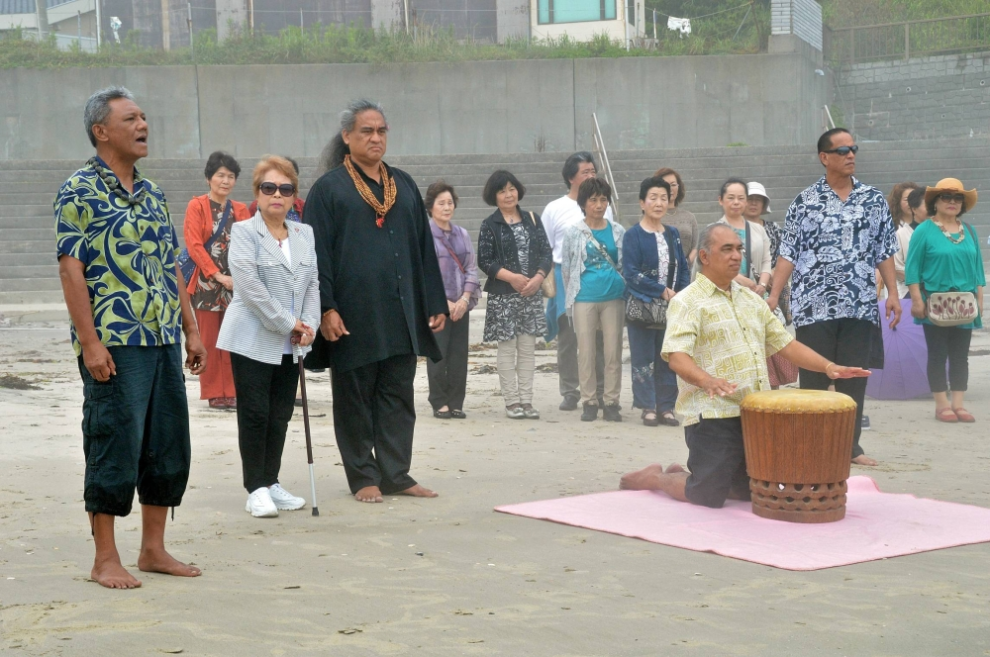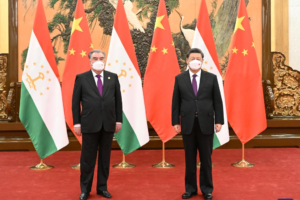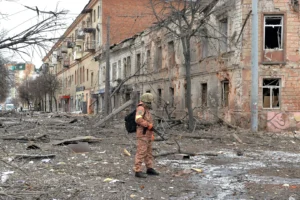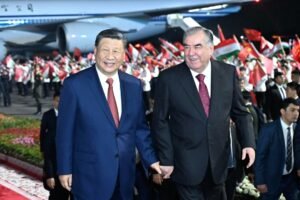In the corner of the Hachiman Shrine in the Arai district of the city of Fukushima, there stands a tall and unusual red-brick tower. It is a monument with the names of those who emigrated overseas about a century ago, mainly from the western part of the city.
Yoshiko Sato, 82, from the Sabara district of the city, has a grandfather who emigrated to Hawaii. The grandfather’s name, as well as the names of Sato’s other relatives who went to Brazil, are inscribed on the monument. “They must have left their hometown with a strong sense of determination,” Sato said, thinking about how her ancestors had had to make difficult choices when their farming business failed.
During the Meiji and Taisho eras, which spanned from 1868 to 1926, many people in the Arai district lost their farmland due to flooding from the Arakawa river and bad harvests. Damage from cold weather and other factors also made life difficult.
Residents emigrated to Hawaii and other places to cultivate undeveloped land, and made a living by working hard in sugarcane fields and at sugar factories.
Fumiko Sato, 75, Yoshiko Sato’s cousin who lives in Arai, says that her paternal grandfather, Hyosuke Sato, went to Brazil, while her maternal grandfather, Kazo Takahashi, went to Hawaii. Growing up, she was told that they went through a lot of difficulties while living alone in a foreign land under harsh conditions.
Takahashi was grandfather to both Fumiko and Yoshiko. In Hawaii, he worked carrying harvested sugarcane on his shoulders, which resulted in the deformation of both of his ears. After returning to Japan, Takahashi never spoke of the hardships he went through. “He must have worked hard for his family under the scorching sun,” Yoshiko Sato said, expressing gratitude for her grandfather.
According to data from the Foreign Ministry, about 4,800 emigrants from Fukushima Prefecture headed to Hawaii between 1898 and 1912. Of these, 1,400 were from former Date County and 1,470 were from Shinobu County (now Fukushima City), accounting for nearly 60% of the total.
Shigeru Konno, 75, a journalist and researcher on emigrants from Fukushima Prefecture, says that among those who went to Hawaii from the Tohoku region, the highest number left from Fukushima Prefecture. Many people in the Date region emigrated to Hawaii after being forced to leave their land due to damage from cold weather and other factors, Konno explained.
Otoji Okazaki, from the town of Kori in the Date region, was the first emigrant who relocated to Hawaii from Fukushima Prefecture. After landing in Hawaii on the first Tohoku emigrant ship in 1898, he worked in the sugar cane fields, and then opened a clothing store.
His success story is said to have spurred enthusiasm among others in the prefecture to emigrate overseas. At one point, there were 13 companies in the city of Fukushima alone that provided assistance for emigration.
The monument at the Hachiman Shrine was completed in 1917. Emigrants from the Arai district who went to Hawaii played a central role in raising funds for its construction. The names of the nearly 200 emigrants who provided support for its construction are inscribed, along with the names of their village of origin and the place to which they emigrated.
The story behind the monument “needs to be passed down to future generations as a historical document,” said Yoshiko Sato. As a member of the local historical research society, Sato is determined to protect the property symbolizing the history of emigrants who had supported their hometowns and families.

This year marks the 100th anniversary of the founding of the Honolulu Fukushima Kenjinkai (the Honolulu society of people from Fukushima Prefecture) in the state of Hawaii. Fukushima Prefecture and Hawaii have a deep history and have strengthened their ties through personal exchanges and mutual support, especially during disasters.
Fukushima Gov. Masao Uchibori attended a commemorative ceremony in Honolulu on Oct. 29 to celebrate the milestone of the centurylong relationship between the prefecture and Hawaii.
Mutual support
The city of Iwaki in Fukushima Prefecture is known as the “Hawaii of Tohoku” due to its warm weather throughout the year. Among cities in the prefecture, Iwaki has maintained special ties with Hawaii through cultural exchanges and mutual support.
People in Hawaii offered support for Iwaki after the 2011 Great East Japan Earthquake and meltdown disaster that followed at the Fukushima No. 1 nuclear power plant, as well as after a deadly typhoon in 2019 that claimed dozens of lives in the prefecture.
After a massive wildfire broke out on the Hawaiian island of Maui in August, Iwaki has been active in fundraising activities to return the favor. The spirit of mutual aid is alive and well, with an event to help support recovery from the wildfire being planned for Nov. 23 at a community center in Iwaki.
Iwaki became a friendship city with Kauai County in Hawaii in 2011 and an international sister city in 2016, with active exchanges having taking place since.
After the 2011 disaster, descendants of Japanese emigrants in Hawaii worked hard to support people in Fukushima Prefecture, including by inviting local children to Hawaii as well as by collecting donations and giving them to the prefecture.
Hula dancers from Hawaii visited Iwaki after the disaster and performed dances on the beach as a form of prayer for the victims. They also visited temporary housing units to offer the residents encouragement. “We felt very grateful for the support from Hawaii,” said Tsuneo Suzuki, 72, president of the Iwaki Hawaii exchange association.
The city is planning a hula stage and other programs at the November event, and Suzuki says he wants many citizens to attend to help support reconstruction efforts.
A century of friendship
The connection between Iwaki and Hawaii dates back more than 100 years. Tomizo Katsunuma (1863-1950) from the town of Miharu, who is known as the “father of Fukushima emigrants in Hawaii,” went to the United States in 1889 and became the first Japanese national to obtain U.S. citizenship. He eventually served as an immigration officer in the Republic of Hawaii at the time, and on his temporary return to Japan in 1898 he began appealing for more people to emigrate from Fukushima Prefecture to Hawaii.
Katsunuma’s father was a jujitsu master in the present-day Iwaki area, and descendants of the Katsunuma family live in Iwaki even now.
Traditional Hawaiian culture, especially hula dancing, also played a role in promoting exchanges. When the Joban Hawaiian Center (now Spa Resort Hawaiians) opened in Iwaki in 1966, hula culture took root. New exchanges were born as hula dancers from the facility actively took part in training sessions in Hawaii.
In 2006, the movie “Hula Girls,” which portrayed the story of hula dancers at the Joban Hawaiian Center, became a big hit. Today, the Hula Museum at Spa Resort Hawaiians introduces the historical background, stories and instruments used in the hula, with colorful costumes on display inside the premises.
Hitoshi Sekine, 60, managing director of Joban Kosan, which operates the facility, is confident that the ties that have been built will continue for the next 100 years. “The Hawaiian culture has taken root in Iwaki. I am sure that mutual exchanges will continue for many more years to come,” he said.
Source : TheJapanTimes











